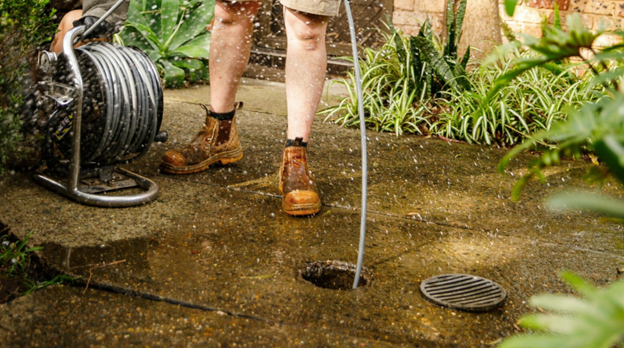Commercial buildings often face plumbing issues due to high usage, aging infrastructure, or external factors. Depending on the type of damage and the location of the pipes, different repair methods are used. Here are some of the most common commercial pipe repair methods:
-
Pipe Relining (Cured-in-Place Pipe – CIPP)
- Overview: This trenchless repair method is used to fix leaks or cracks without having to dig up the existing pipes.
- How It Works: A flexible liner coated with resin is inserted into the damaged pipe. It is then inflated and cured, hardening to create a new pipe inside the old one.
- Advantages: Minimally invasive, cost-effective, and reduces downtime. Suitable for repairing long stretches of piping.
- Best For: Sewer lines, stormwater drains, and other underground pipes.
-
Pipe Bursting
- Overview: A trenchless technique used to replace severely damaged or collapsed pipes breaking the old pipe and pulling a new one into place.
- How It Works: A bursting head is inserted into the old pipe, breaking it apart while dragging the new pipe behind it through the same space.
- Advantages: No need for extensive excavation. Can replace old pipes with larger ones, increasing capacity.
- Best For: Water mains, sewer lines, and pipes that are too deteriorated for relining.
- Epoxy Pipe Coating
- Overview: An alternative to pipe replacement that involves coating the interior of the pipes with epoxy to seal small cracks and leaks.
- How It Works: Pipes are first cleaned to remove rust, scale, or debris, then a liquid epoxy is applied to the interior of the pipe. Once cured, the epoxy forms a smooth, durable lining.
- Advantages: Restores the pipe’s integrity without the need for excavation. It’s also corrosion-resistant.
- Best For: Smaller diameter pipes, potable water systems, HVAC systems, and pipes that don’t require full replacement.
-
Spot or Sectional Pipe Repair
- Overview: A targeted repair for isolated pipe damage, such as small leaks or cracks.
- How It Works: Only the damaged section of the pipe is exposed and replaced with new piping or a patch, instead of replacing the entire pipe.
- Advantages: Cost-effective, faster than full pipe replacement, and minimally invasive.
- Best For: Leaks or damage in small, easily accessible sections of piping, especially in walls or ceilings.
-
Mechanical Pipe Repair Clamps
- Overview: A quick fix for localized leaks, often used as a temporary or emergency solution.
- How It Works: A clamp with a rubber gasket is secured around the damaged portion of the pipe to seal the leak.
- Advantages: Quick and simple to install, provides an immediate solution.
- Best For: Temporary or emergency repair of leaks in pressurized water lines, including pipes in difficult-to-access areas.
-
Traditional Pipe Replacement (Excavation)
- Overview: The conventional method of repairing or replacing pipes digging up the damaged pipe and installing new piping.
- How It Works: Trenches are dug to expose the damaged pipes, which are then removed and replaced with new pipes.
- Advantages: Full visibility of the damaged area, allowing for complete replacement. Necessary for pipes that are too damaged for trenchless methods.
- Best For: Pipes that are severely damaged, collapsed, or where trenchless methods are not feasible (e.g., large commercial water mains).
-
Hydraulic Pipe Replacement
- Overview: This method uses hydraulic power to push a new pipe through the damaged pipe, expanding the old pipe outward as the new pipe is installed.
- How It Works: Hydraulic equipment forces a new pipe through the existing, weakened pipe, which bursts or expands the old pipe as the new one takes its place.
- Advantages: Similar to pipe bursting, but uses hydraulic pressure for stronger, more precise insertion.
- Best For: Underground pipes where minimal disruption is important, and the existing pipe needs to be replaced without excavation.
Conclusion:
Commercial pipe repairs depend on the nature and extent of the damage. Trenchless methods (like pipe relining and pipe bursting) have become increasingly popular due to their cost-effectiveness and minimal disruption, but traditional excavation may still be necessary for severely damaged pipes. Using the right method can save time, money, and prevent further damage to commercial properties.
At Manchester Plumbing and Heating, we understand that reliable plumbing and heating systems are the backbone of any comfortable home or business. Whether it’s a sudden plumbing emergency, an upgrade to your heating system, or routine maintenance to keep things running smoothly, we’ve got you covered with fast, professional service you can trust.
Here’s why you should choose Manchester Plumbing and Heating:
- Expert Technicians: Our highly trained and certified team brings years of experience to every job, ensuring top-notch workmanship and safety standards for all your plumbing and heating needs.
- 24/7 Emergency Services: Plumbing and heating problems don’t keep office hours, and neither do we! We offer round-the-clock emergency services, so you’re never left in the cold or dealing with a plumbing crisis alone.
- Comprehensive Solutions: From routine maintenance, installations, and repairs to complete system overhauls, we provide a full range of services tailored to your specific needs, whether it’s residential or commercial.
- Energy Efficiency: We specialize in energy-efficient heating systems that not only keep your property warm but also save you money on your energy bills.
- Customer Satisfaction: Our commitment to providing excellent service has earned us a reputation for reliability, transparency, and quality. We don’t just meet expectations—we exceed them.
Let Manchester Plumbing and Heating be your go-to partner for a seamless, worry-free experience. Call us today, and see why countless customers trust us to keep their homes and businesses running smoothly!

Manchester Plumbing and Heating
50 Hampton Grove, Walmersley, BL96PT
Email: info@manchesterplumbingandheating.co.uk
Website: https://manchesterplumbingandheating.co.uk/
Follow us:



